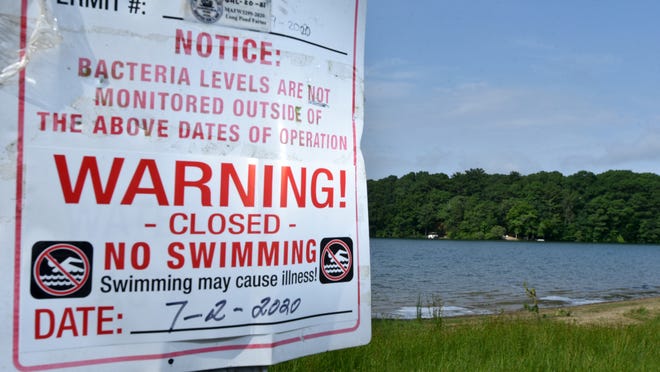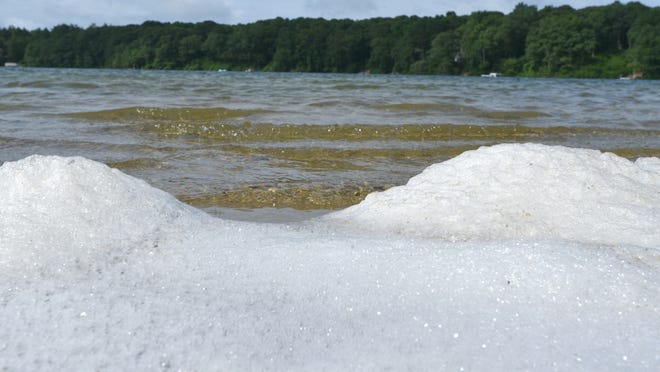Cape ponds test positive for toxic bacteria
Doug Fraser
dfraser@capecodonline.com
Cape Cod Online
May 30, 2021

Recent testing of approximately 70 of the Cape’s 996 ponds and lakes revealed the presence of toxic bacteria in a handful of them.
These cyanobacteria are naturally occurring and produce toxins that can harm dogs and humans. Their proliferation is being aided by global warming and nutrient pollution by septic systems and stormwater runoff.
These blue-green algae are among the oldest life forms on earth, with a fossil record dating back 3.5 billion years, and scientists credit them with some pretty critical planetary milestones, such as building the atmosphere and the beginning of plant life on Earth. Cyanobacteria remain an essential part of the food chain, but nutrients from septic system effluent and lawn fertilizer, combined with a longer and warmer growing season due to climate change, can produce explosive growth, and the toxins they produce are present in high enough concentrations that breathing or swallowing them can cause skin and eye irritation, gastrointestinal symptoms, asthma-like symptoms or even liver or neurological damage.
This can prove fatal to dogs, and sometimes humans as well.
“Compared to COVID-19, it’s not at the same level. It hasn’t killed anybody in Massachusetts,” said Karen Malkus-Benjamin, coastal health resource coordinator for the town of Barnstable.
“Over the years, there’s more and more and it’s something we need to address,” she said.
When a cyanobacterial bloom is peaking, a scum forms on the pond surface that is hard to mistake for anything else. It’s a very strange color: neon green or blue, or sometimes red. “Some people say it looks like spilled paint,” Malkus-Benjamin said. Unlike other algal blooms, this one is impossible to pick up. Cyanobacteria are single-celled organisms connected to one another in colonies by a mucous membrane that falls apart when disturbed.
Sometimes the bloom emits an odor like a cut lawn or other earthy smells. Two dogs who died after eating blue-green scum at Cliff Pond in Nickerson State Park in 1998 could have been attracted to the raw meat smell produced by that bloom, Malkus-Benjamin said.
But it’s not just people and pets that are affected. The health of the pond is at stake.
“It’s a sign the ecosystem is out of balance,” Malkus-Benjamin said. “It’s telling you something is wrong.”
This may be the fate of more Cape Cod ponds and lakes as the region struggles to clean up a wastewater problem whose solution could cost in the billions.
In October, the Association to Preserve Cape Cod unveiled the results of a two-year study funded by the Massachusetts Environmental Trust that indicated one-third of 149 monitored ponds had unacceptable water quality due to excess nutrients, particularly phosphorus, from septic systems and lawn fertilizer.
“The driver is nutrients,” association executive director Andrew Gottlieb said, although some ponds may have natural deposits of phosphorus on the bottom that get recycled into surface waters by natural events such as the change from summer heat to brisk fall temperatures.
The state does not require testing for cyanobacteria, but the Cape association, the federal Environmental Protection Agency and the University of New Hampshire developed a test that is cheaper than using a state or private lab, with a $100 per sample cost for test results completed within 24 hours.
“To get the state Department of Public Health to do that within 24 hours would cost $500,” Gottlieb said. He said the cost reduction allows them to do more tests and make predictions as the bloom is forming, allowing for early warnings to swimmers and other water users as well as pet owners.
Last year, APCC tested 30 ponds and lakes, with 11 determined to have a bloom at actionable levels where an advisory or closure was warranted, Gottlieb said. Samplers take water temperature, measure water clarity and then collect water, which is frozen to kill the bacteria to preserve a snapshot of the bloom. It is then thawed and run through a fluorometer, an instrument looking for the specific wavelength of reflected light that is produced only by cyanobacteria. Since toxicity varies by species, a technician then uses a microscope to determine which cyanobacteria are present.
“It’s a new program, and most towns are not set up or budgeted to deal with this sampling,” Gottlieb said.
APCC had hoped to expand the testing to 100 lakes and ponds, but COVID-19 restrictions reduced its access to volunteers. A single staff member and two seasonal interns do the bulk of the sampling and testing for 35 ponds.
As of this week, they had found blooms in five ponds: Mares and Deep ponds in Falmouth, Long Pond in Marstons Mills and Walkers and Cliff ponds in Brewster.
The state Department of Conservation and Recreation said Cliff Pond is not currently experiencing a cyanobacteria bloom, and tests by APCC showed small amounts of the bacteria present that are due to natural processes, not pollution. In June, the agency decided there was no need to post an advisory, and the pond continues to register low cell counts.
Barnstable tests about 40 of its 182 ponds, with priority generally determined by the amount of use by people. So far this year the town has closed two ponds: Long Pond in Marstons Mills and Lovells Pond beach. Meanwhile, warnings have been put up at No Bottom, Cotuit and Shubael ponds.
While some might consider this a warm-weather problem, the bloom in the Santuit River and Santuit Pond in Mashpee last year lasted into December.
“It’s now in the fifth year of the program and we’re finding that (the blooms) start earlier than expected, that they are more prevalent with a higher degree of toxicity and last longer,” Gottlieb said.
Follow Doug Fraser on Twitter: @dougfrasercct.

Cape ponds test positive for toxic bacteria – Cape Cod Online
